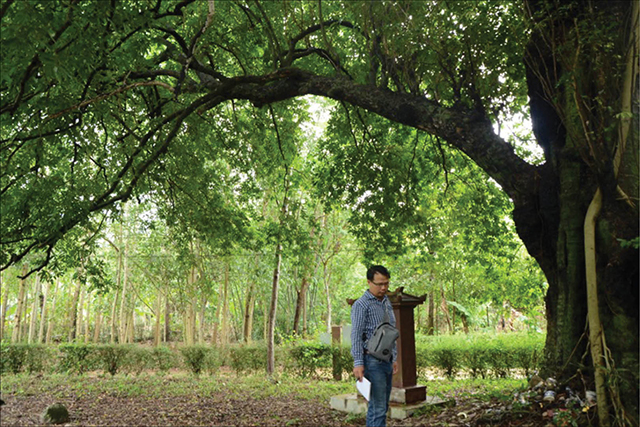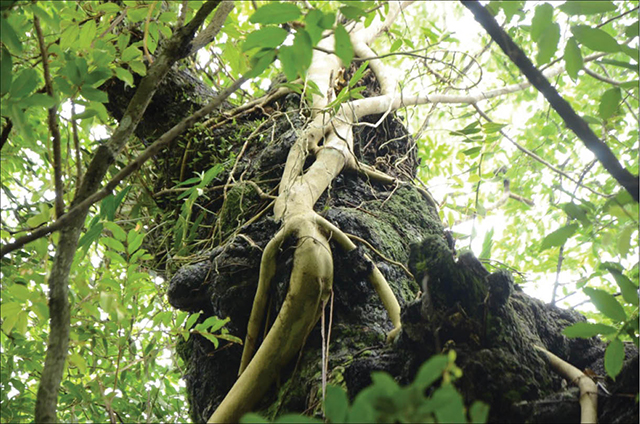The Institute of Monuments Conservation, Institute of Natural Resources and Environment, Hue University have signed a contract on the "Survey of the heritage golden apple tree in Phuoc Tich ancient village, establishing technical measures to ensure the tree’s survival and growth."

A branch of the heritage golden apple tree at risk of breaking
Immediately after signing the contract, the Institute of Natural Resources and Environment, Hue University set up a unit to survey the site and identify factors affecting the tree and factors impacting the tree negatively in order to provide feasible technical solutions for the rescue, protection and care of the heritage golden apple tree. The Institute of Natural Resources and Environment, Hue University also organized a consultation workshop on "Establishing technical measures to ensure the survival and growth of the heritage golden apple tree in Phuoc Tich ancient village, Phong Hoa commune, Phong Dien district, Thua Thien province".
Dr. Truong Thi Hieu Thao, a botanist from Hue University of Education, highlighted the biological, ecological and classification characteristics of the heritage golden apple tree and introduced a list of plant species living on the bark of the heritage tree. In particular, a liana is developing a root system that encloses the golden apple tree trunk. This plant must be eliminated.
Dr. Le Anh Tuan, a cultural and art expert at the National Arts and Cultural Institute in Hue, has raised concerns about the negative social impacts to the survival of the heritage golden apple tree, relating to beliefs, customs, local people’s awareness, history, heritage...

A liana on the treetops of the heritage golden apple tree
Mr. Tran Hieu Quang, M.Sc., from the Institute of Natural Resources and Environment, Hue University presented 3 categories of technical solutions to rescue, protect and care for the heritage golden apple tree, including the category of solutions that directly impact on the heritage tree (removing the liana, lichens, algae and ferns; making frames to protect the branches with the risk of breaking; pruning and creating canopy); the category of solutions to improve the surrounding environment (cleaning and removing rubbish around the roots; removing forest trees around the heritage tree that have potential negative impacts; removing power poles out of the tree’s canopy, etc.); and the category of solutions relating to the community (specifying regulations for visitors and pilgrims to limit the burning of candles, incense, and votive paper under the tree; setting up management measures with regulations to protect the heritage tree; building funds for the care and conservation of the heritage golden apple tree; raising awareness of the people about the protection of heritage trees ...).
Attending the discussion, the participants contributed many ideas for the contents of the reports. Overall, the participants highly appreciated the Institute of Natural Resources and Environment, Hue University for their work and were in agreement with the results of the survey and the technical solutions proposed by the Institute of Natural Resources and Environment, Hue University.
To contribute to the rescue, protection and effective care of Phuoc Tich’s heritage golden apple tree, many delegates added some recommendations with the hope that the Institute of Natural Resources and Environment, Hue University will take in consideration to increase the efficiency of the conservation of the heritage tree in both short and long terms. Some suggested that there is a need to have regulations to protect the heritage golden apple tree from local people as well as tourists. It is also essential that the local community contribute to the embellishment of the landscape surrounding the heritage tree; linking the preservation of the heritage golden apple tree with new rural construction programs, building short-term and long-term concrete plans to propose to the People's Committees of communes and districts for support. In addition, there were some comments about the promotion of the heritage tree through tourism products such as using the design of the heritage tree on pottery, the propagation of the heritage golden apple tree...
In addition to the above solutions, attention should be paid to the treatment of the tree’s hollow. Although there is an opinion that the heritage golden apple tree has been living with the hollow for almost a hundred years, the hollow is the culprit behind the reduction of the life span of the tree.
Biologically speaking, the development of the hollow is inevitable in mature golden apple trees. The hollow increases with the growth of the tree. If the tree is healthy, the new wood growth will increase the diameter of the trunk, compensating for the hollow to help the tree transport water and mineral salt from the roots to the leaves. However, if the trunk is damaged too quickly by external factors (fungi, bacteria, insects, etc.), the hollow will develop excessively, which decreases the mechanical resistance of the tree and create an environment for micro-organisms to penetrate deeply into the remaining trunk. This increases the risk of the tree breaking in storms.
Story and photos: Do Xuan Cam